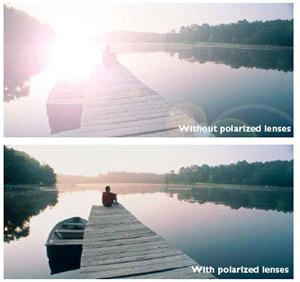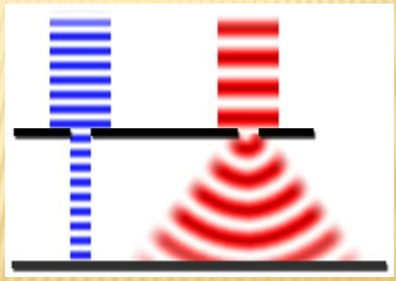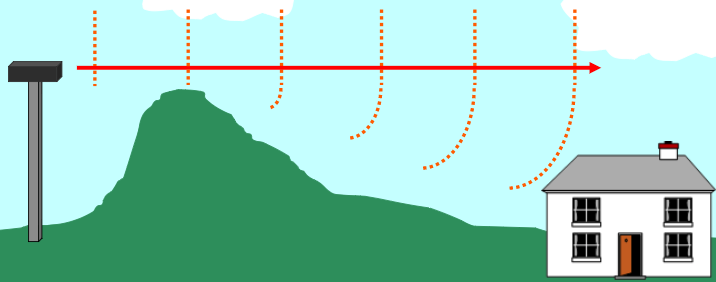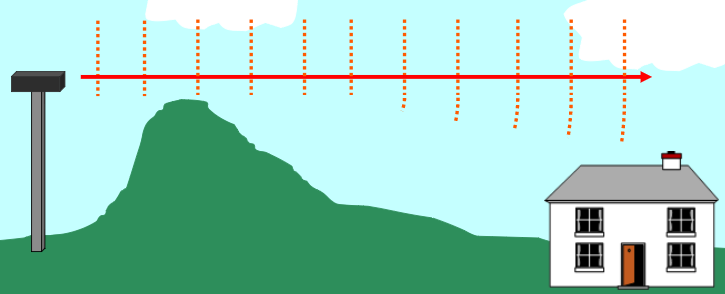More Properties of Light Waves
M. Rocha
Physics 4C
Total Internal Reflection, Polarization, Diffraction & Interference
Total Internal Reflection
Direction of Refraction

Waves bend towards the normal when going from fast to slow
and
away from the normal when going from slow to fast
Total Internal Reflection

When refraction angle exceeds 90º from the normal the light does not cross the interface


Fiber optics
Total internal reflection causes light to reflect inside a solid glass/plastic tube
Atmospheric Refraction

Wave fronts of light travel faster in the hot air near the ground, thereby bending the rays of light upward

Polarization
Polarization


If a rope is shaken up and down, a vertically polarized wave is produced.
If a rope is shaken from side to side, a horizontally polarized wave is produced
A vertically vibrating electron emits vertically polarized light.
A horizontally vibrating electron emits horizontally polarized light
Polarization


Polarization
Reflection of light from non-metallic surfaces results in polarization parallel to the surface

Most glare is horizontally polarized
Polarized Light and 3-D Viewing

A 3-D slide show uses polarizing filters. The left eye sees only polarized light from one projector; the right eye sees only polarized light from the other projector

Diffraction and Interference
Wave Diffraction
Diffraction is the bending of a wavefronts as they pass the edge of an object

Huygens' Principle
Every point of a wavefront may be considered the source of secondary wavelets that spread out in all directions
Huygens' principle explains wave diffraction

Wavelength and Diffraction
Diffraction is greater when the wavelength is large compared to the size of the object or aperture

Checkpoint 1
Two light rays of different wavelength (one blue and one red) go through a small slit opening. For which one would you expect stronger diffraction?
For the red light ray


Wavelength and Diffraction
Diffraction is greater when the wavelength is large compared to the size of the object or aperture


Long wavelength (> 100 m) radio waves diffract more from mountain tops, reducing shadow regions
Short wavelength (< 100 m)
radio waves diffract less, casting shadow regions.
f < 3 MHz (AM, VLF, LF, MF )
f > 3 MHz (FM, HF, VHF)
Diffraction Interference Pattern


Wave Interference in 2D




Diffraction and Interference

Constructive Interference
Destructive Interference
Diffraction and Interference

Interference Patterns are Wavelength Dependent
IF THEN constructive interference
IF THEN destructive interference
Where is the difference in distance traveled between waves from different sources
and m = 0,1, 2, 3, ... is an integer number


Checkpoint 2
By how much should a pair of monochromatic light rays differ in distance traveled to produce destructive interference?
By multiples of 1/2 wavelength
Interference Pattern as a function of wavelength

Double-Slit Interference
IF THEN constructive interference
IF THEN destructive interference
Double-Slit Interference


Multiple-Slit Interference

Diffraction Gratings

A multitude of closely spaced parallel slits makes up what is called a diffraction grating
a diffraction grating separates colors by interference
Interference From Thin Films




Interference From Thin Films
As the thickness of the soap layer changes, different different wavelengths of light are canceled

Interference From Thin Films
Two things to consider:
- Phase inverts if n2 > n1
- Wavelength changes as speed changes
Checkpoint 3
Constructive interference occur when
What is the smallest thickness of a soap bubble that produce constructive interference for red light of 650 nm? Use n = 1.33 for soap and assume light rays travel perpendicular to the film
Thus the smallest thickness is